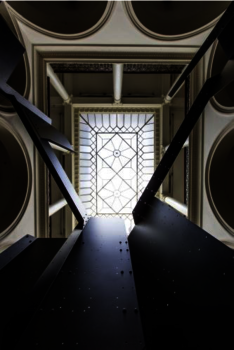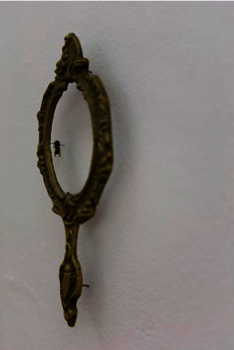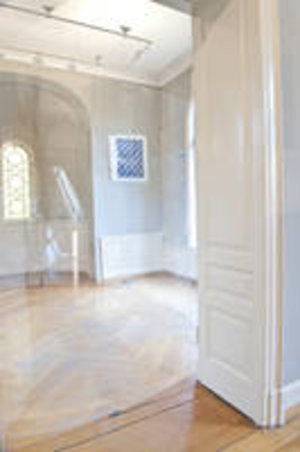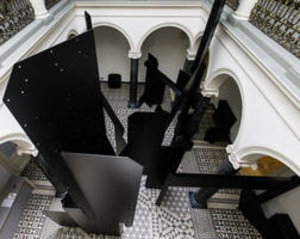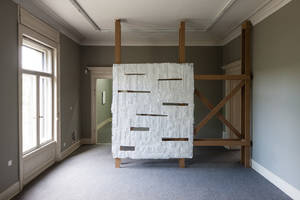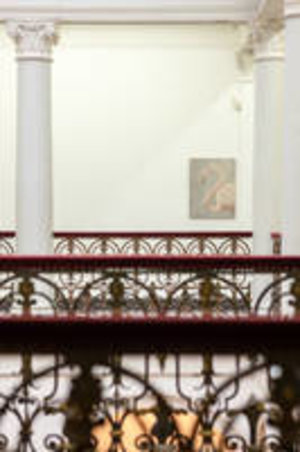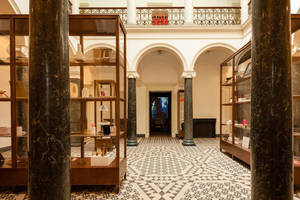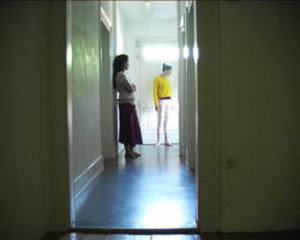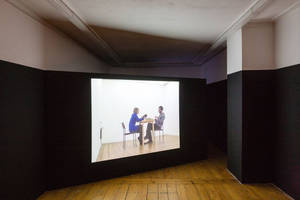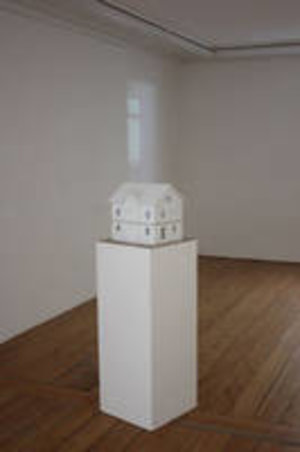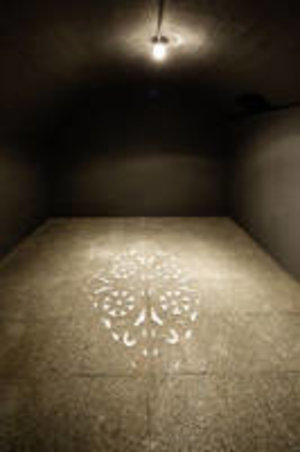23 November 2012 – 3 February 2013
"Vergessen Sie nicht die Wuchskraft der Bambuswurzeln! - Klasse Reto Boller
Opening: 22 November 2012, 7:30 pm
Villa Merkel
The Villa Merkel and the Bahnwärterhaus become a platform for current artistic approaches. An expanded discourse on painting is on offer: a group of 27 artists from the Staatliche Akademie der Bildenden Künste Stuttgart – students, graduates and visiting students from Reto Boller’s class – are introducing themselves in an international context.
What is happening here is artistic exchange within the group, and promotion of individual work. The class produces together and exhibits as an ensemble. The variety of approaches explores the boundaries between painting and object and installation art. What we see is a richly varied survey, starting with questions about painting and moving on to installation-based and performative positions.
Reto Boller´s own artistic works develop themselves out of a bold and innovative borderline between painting, objects and installation. Thereby a wide range of industrial material is used. In continous processes new real and pictorial spaces acquiesces and the works Reto Boller´s pass in the sense of a work in progress a kind of metamorphosis which evokes new situations.
Works of reto Boller might tend to draw connections to Post-Minimal or even a deconstructive conceptional approach. Nevertheless these clues prove to be neither efficient nor wants Reto Boller to follow up any of these concepts. Instead, new will be created.
23 November 2012 - 3 February 2013
Adrien Tirtiaux – Die weißen Wände der Welt
Opening: 22 November 2012, 7:30 pm
Villa Merkel
The Villa Merkel is presenting an extensive solo exhibition introducing the Belgian artist Adrien Tirtiaux. Tirtiaux is a trained architect and artist who addresses three-dimensional situations. He is creating a pathway through the upper storey of the Villa Merkel looking at possibilities and impossibilities for the model in the context of artistic and architectural creativity.
The spectrum runs from utopian and unrealized projects via the political dimension of building planning, ending up with an aesthetic tribute to the model as such. Tirtiaux uses the villa itself as a model, and modifies the exhibition galleries by means of radical but also subtle interventions.
Videos and installations present evidence of poetic, performative spatial explorations: for example, an allotted bunk is converted into a raft without further ado, and conveys the artist from Groningen to the sea (It’s a long way to the sea, 2006).
Constantly changing architectural interventions by the artist are also being created at present in The Hague (THE GREAT CUT, Stroom Den Haag) and Tours (MONUMENTALE ACADEMIE, ESBA Tours). A documentation updated during the exhibition period will be shown in the Villa Merkel to accompany the creative process.
Adrien Tirtiaux is a member and co-founder of the “Hotel Charleroi” collective, research and residential programme. Charleroi is a town on the periphery of Brussels that is undergoing a massive structural transformation. “Hotel Charleroi” offers artists the opportunity to spend time in Charleroi and to use the urban space as a studio and laboratory.
Adrien Tirtiaux (b. 1980, Brussels) lives and works in Antwerp, Belgium. Part of the exhibition is being created in co-operation with Helmut Heiss (b. Bolzano, lives and works in Vienna).
8 July – 2 September 2012
Tobias Putrih – White City
Villa Merkel
In summer 2012 the Villa Merkel will host a solo show by the Slovenian artist Tobias Putrih. His work engages with particular aspects of modernist history such as political and social utopianism, modernist architecture and design and the origins and evolution of cinema.
Several of Tobias Putrihs site-specific installations have re-imaged cinema interiors through the creation of life-size environments. Some of these are accessible and can be used. Actual films can be projected. Other cinema interiors are not accessible and do not function in a proper sense. The series of deconstructed cinemas reviews the cinema in terms of social aspects. Other, large-sized, spatial works point out previous utopians, idealistic ideas of artistic production or previous experiments by architects, designers and scientists.
For example, some works refer to the Bauhaus or artists such as Richard Buckminster Fuller, Chris Marker and Robert Smithson. In this context, small-scale models often represent structures that would be impossible to construct or use in life-size. The objects, made of materials which can be easily removed and disposed, seem provisionally. Tobias Putrih uses everyday materials such as cardboard, Styrofoam™, tape and plywood to produce fragile structures. In this condition the object seems to remain a proposal for a sculpture or an architectural space.
Tobias Putrih (*1972, Kranj, Slovenia, works and lives in Cambridge (MA), USA) has exhibited his work to great acclaim in Europe and America. Among other things he represented Slovenia at the 52nd Venice Biennial in 2007.
The show at Villa Merkel, Galerien der Stadt Esslingen am Neckar will be the first comprehensive solo exhibition by Tobias Putrih in Germany.
22 April – 24 June 2012
Melanie Smith – Short Circuit
Villa Merkel
Melanie Smith, based in Mexico-City since 1989, deals with a wide range of issues of perception. Within her work visual contents of Western modernity are developed, analysed and brought into context with Latin American culture.
Within the video Xilitla Melanie Smith focuses the sculpture park Las Pozas de Xilitla, which was built by the English artist James Edwards in the 20th century. In Midst of the Mexican tropical rain forest a surrealistic landscape of architecture and concrete sculptures was constructed, which should imitate orchids amongst others. Smiths at first sight documentary like video work is enhanced into surreal when man-sized mirrors are carried through the image.
The paintings of Melanie Smith bring surfaces and process-related situations into focus. The pictures oscillate considering their perception constantly at the border between an almost appearance and the mere visual reality of the image. Picture by picture one imagine oneself at the beginning of something new. Acuminated moments of a physical experience – literally as well as in the sense of a visual representation – will be effected within the exhibition. Also socio-politically motivated works, like Bulto, are characteristic for Melanie Smith and will be shown.
The exhibition is the first institutional solo show of Melanie Smith in Germany and especially new developed video works, paintings and installations will be partly shown.
22 April 2012 – 8 July 2012
Saatgut – Emblements – Gran
Anike Joyce Sadiq (22 April – 13 May)
Max Santo (20 May – 10 June)
Ines Wuttke (17 June – 8 July)
Bahnwärterhaus
From 22 April until 8 July 2012 the project Saatgut – Emblements – Gran will take place in the Bahnwärterhaus, Galerie der Stadt Esslingen am Neckar.
Perfomances
17 June, 11am, 30 June, 7pm, 8 July, 1pm
Over a period of three weeks ANIKE JOYCE SADIQ [Prof. Birgit Brenner at the Staatlichen Akademie der Bildenden Künste Stuttgart], MAX SANTO [Prof. Henning Kürschner at the Universität der Künste Berlin] and INES WUTTKE [study of media art and scenography at the Staatliche Hochschule für Gestaltung Karlsruhe] will show installation and performances specially created for the Bahnwärter-
haus. The examination of illusion and fiction is inherent in all three positions.
ANIKE JOYCE SADIQ creates spaces in which the observer may interact. These spaces develop into rooms for manoeuvre where the viewer may question his own perception. Is it possible to raise a truth-claim out of a video-projection where the visitor as well as the artist acts, but only the visitor may find himself within the projection room? Installation and performances are linked and integrated.
With INES WUTTKE performance continues. What is new is that the full concentration is placed on course of actions of a situation. Several times performances will take place, which relies on minimal medium staffage. The Bahnwärterhaus is the stage, the spectator may operate. Fiction is generated by a narrative thread. An exploration of borders between performances and theater takes place.
MAX SANTO often places found objects in relation to apparently create confusion. The arrangement begins to tell a story. For the exhibition in the Bahnwärterhaus Max Santo occupies the accomodation and places them in a new context. Mirrored situations confuse the viewer and evoke a chimera. Almost every presentation appears as a root search, a trench for the seed, the quintessence of sooth. This creates situations that tell their own story, installations that create fiction in the illusory moment. The artists set the seed. Chimeras and illusions encourage the viewer to think further and bring cognitive processes in motion.
On the occasion of the exhibition a catalogue will be published by EDITIONrandgruppe.
The exhibition is curated by Maria Wäsch.







